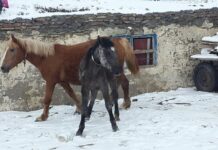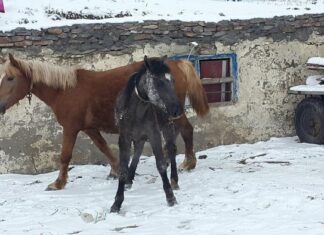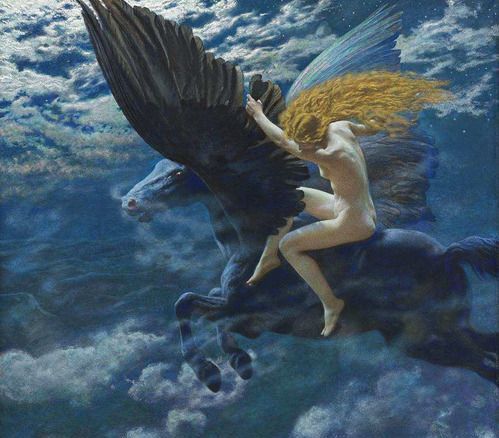The Dove And The Crow (Anonymous: 2nd Century B.C. or later)
It is thought that the collection of fables now known as the Panchatantra had assumed definite shape at least as early as the Sixth Century A.D., and it is possible that it dates back to the Second Century B.C. Nothing is known of the author. The little stories that make up the collection are mostly Beast Fables, which were originally designed to instruct young princes. “Panchatantra” means “five books.”
The present story, from the second book or Tantra, is reprinted from Ancient Indian Fables and Stories, by permission of the publisher, John Murray. It has no title in the original.
The Dove And The Crow
When Vishnu Sarma had finished telling and expounding these fables, his pupils were lost in admiration of their teacher, whose wisdom had been so clearly marked by his dexterous mingling of amusement with instruction. They rose and all three fell at his feet, thanking him for the wise lessons he had given them; they assured him that henceforth they would regard him as their guru and that they hoped with his help and advice to rise from the state of ignorance in which they had hitherto been. They prayed him to continue the work so happily begun and to give them more of his interesting lessons.
Vishnu Sarma was charmed to see that his pupils were well disposed and noticed with satisfaction that his plan had so far succeeded. He continued his task with enthusiasm and proceeded to tell them fresh fables.
“Now,” said Vishnu Sarma, “listen, my young princes, to the fable I am going to tell you. In the complex nature of this life we must all help one another. It is by this mutual help that the weak escape the dangers, to which they are exposed from the strong, as you shall now hear.”
A certain dove, by name Chitrani, had built her nest on the top of the mountain Kanakachala and was living there comfortably with her family. At the foot of the mountain dwelt a crow. One day Vega- Varma (such was the crow`s name) was flying round in search of food when he noticed a fowler spreading his nets in the way. He was frightened at sight of the danger and at once returned home.
The dove Chitrani passed by the same place with her family, but being off their guard, they all flew into the net and were captured. What was to be done? How could they escape from certain death? There was in fact no escape, no hope of obtaining their liberty. Already the fowler was running up to seize his prey, when all at once under the impulse of danger they took to flight together, carrying with them the net that enclosed them. So they succeeded in escaping, and the fowler, who had reckoned upon his capture, was not a little surprised when he saw them fly away with his nets. But they reached their home in safety still entangled in the nets into which they had flown.
Hiranya Varma
When the crow saw them coming in this strange chariot, he hastened to meet them; and as soon as Chitrani saw him, she told him of their adventures and asked him to help them by disentangling the nets. The crow replied that he could not free them, but suggested a rat of the name of Hiranya Varma who lived close by and who could help them. Accordingly Chitrani called the rat, who came up at once, and when he saw the captives he began to scold Chitrani for her imprudence and folly which had brought them to this pass. Chitrani defended herself and quoted the maxim: “No one, be he never so wise or prudent, can escape his destiny.” Then the rat, pitying the poor doves, called his fellows, and they all set to work to gnaw the knots of the nets, so that very soon they had freed Chitrani and her family.
The crow, who had seen the signal service performed by the rat for the doves, was anxious to make friends with him; he hoped also to obtain a useful ally should occasion arise. He accordingly made over-tures to him; but the rat replied that they were of totally different species, the one living in the air and the other in the earth; he did not see the use of the close friendship of two creatures between whom Nature had fixed such a wide gulf.
But the crow insisted. Matters of personal interest and friendship, he said, are decided by our inclination. We do not consider distance or the difference of condition. So the rat yielded and they swore a close friendship. One day when they were out together they happened to meet a deer; they stopped him and asked his name and where he was going. The deer said he was called Chitranga, told them his story, and asked if he might join them. They readily consented, and so the three struck up a lasting friendship.
One day while they were out together and were very thirsty, in their search for water they found a well into which a tortoise had fallen. As soon as she saw the three friends she begged them to take her out of her prison and to put her somewhere where she could live in comfort. Pitying her plight, they rescued her and took her to a spring of clear water; and she, mindful of this service, also became their friend.
For a long time the four lived happily together, but one day when the deer had gone away to graze he fell into the snare of a hunter. But when the rat saw that his friend the deer was so long in returning, he guessed that he had met with an accident. So he called the crow and told him what he feared and advised him to fly up and try to discover their friend. This the crow did, and after looking about for some time, at last saw poor Chitranga in the snare struggling hard to get out, but in vain.
The crow at once told Hiranya Varma what had happened to their friend, and he, calling his fellow-rats, sallied out to help him. They soon set him free. Chitranga went home with his friends and the acci-dent was soon forgotten. But later on, when the four friends were rest-ing quietly in the shade of a tree, they were suddenly disturbed by the unexpected sight of a crowd of hunters. This alarmed them.
The crow and the deer could easily avoid pursuit, but not so the rat, and least of all the tortoise. The other two would not leave them to the mercy of the hunters, who were coming on quickly, and so the deer undertook to attract attention to himself in order to save the life of his friends. He pretended to be lame. The hunters, seeing him limp and apparently hardly able to hold himself up, all ran to capture the easy prey. But the deer led them a long dance, sometimes quickening his pace, sometimes slowing down, until at last, having made them follow for a long time, he fairly used his four legs and was soon out of sight. Meanwhile the tortoise and the rat had found a place of safetyout of reach of the hunters.
Once more the four friends were united and lived quietly together; these dangers had taught them the value of true unity and of, sincere friendship, and by experience they learned how the weak need to support one another.
Read More about The Shepherdess and the Sweep part 3








